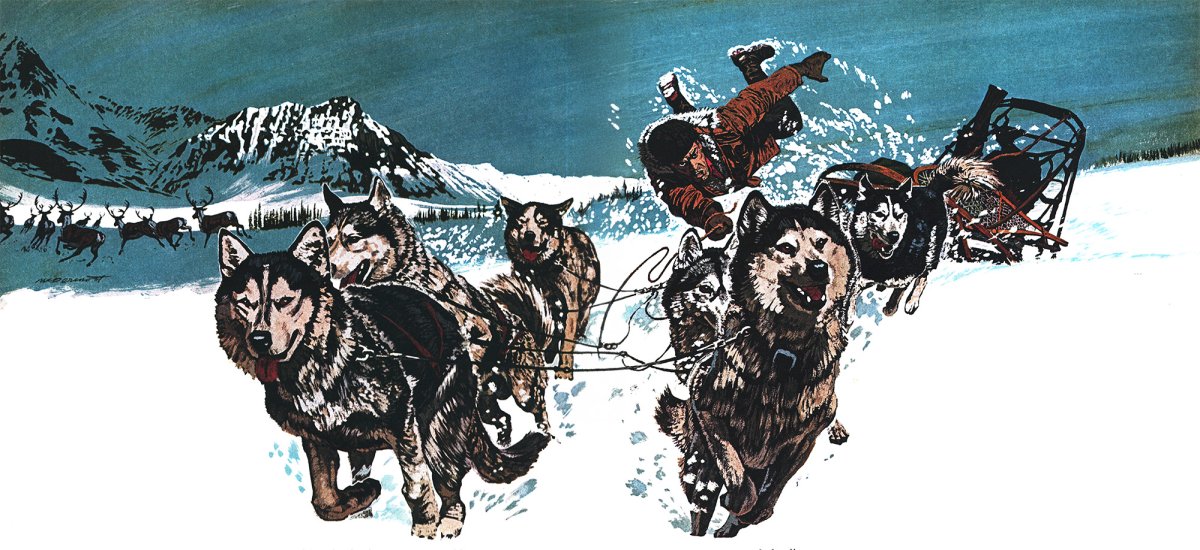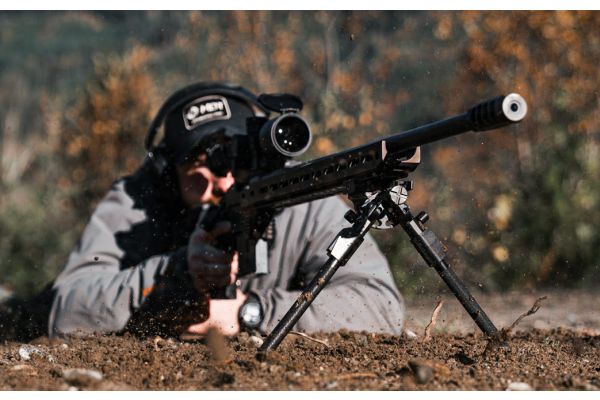This story, “Adventure Was His Life,” appeared in the July 1975 issue of Outdoor Life.
The wolf broke the stillness of the subarctic dawn on the north slope of the great Alaska Range. The sound drifted across the snowy flats, into stunted timberline spruces, over the ice-covered Savage River, and into the log cabin where a trapper was awakening.
Again the wolf howled. Another joined in and then another until it became a chorus.
The trapper, Frank Glaser, left his bed, threw wood into his stove, and dressed. His outdoor thermometer read 40 below zero, which prompted him to pull on another pair of woolen socks. He grabbed his parka as he headed for the door, binoculars hanging from his neck.
He grabbed his rifle from the cold entryway, strapped on snow-shoes, and headed for a nearby lookout, from which he spotted nine wolves two miles away on a flat. A wolf stood to howl, and a cloud of steam rose. A moment later the low, lovely, wild sound reached Glaser.
Several hundred caribou were scattered across the flat beyond the wolves, which were watching their movements and howling.
A small creek meandered within rifle range of the wolves, and Frank ran down the ridge into the creekbottom. His snowshoes scraped and clattered on the hardened March snow, and he bent to remove them. Suddenly two black wolves bounded over a drift 50 yards upstream, heads up, looking. In the creek behind the trapper another wolf appeared.
He snapped a shot at one of the animals and saw it collapse. He centered the scope on the second black one, which had skidded to a stop, and saw it stagger when he fired. He spun and centered on the wolf downstream, fired, and then watched it roll to a stop at his shot.
He got out of the webs and struggled up a hard snowdrift to the streambank. His moccasins slipped, and he had to dig in with the gun butt to pull himself up. He crawled to the top and peered over. The six surviving wolves milled 300 yards away. At his shot they scattered. He emptied the rifle, hitting two.
He followed one of the blood trails for a mile but lost both of the cripples and returned to skin the three he had killed. These were but three of the more than 500 wolves killed by Glaser during his time in Alaska.
Frank Glaser — market hunter, trapper, woodsman, and government hunter — became a legend during his own lifetime. Regular readers of OUTDOOR LIFE will remember the stories I wrote with Glaser recounting some of his Alaskan adventures. The titles and issues are listed [below and here]. Frank was 26 when in 1915 he moved to Alaska from Washington State for the hunting. He arrived with a new .30/06 box-magazine Winchester and a pair of binoculars and settled at Black Rapids roadhouse on the Valdez Trail. There he contracted to sell game meat for 25¢ a pound to the Road Commission, which had crews converting the old trail into the Richardson Highway.

Frank was a compulsive talker (some called him “Silent Frank”), perhaps a result of so many years of living alone. His early years in Alaska was a favorite theme. He would talk about his many encounters with grizzly bears, his years trapping, or how he guided the famed Murie brothers, biologists, on early Alaskan expeditions. He liked to tell how on big-game hunts he guided famous men such as the one he referred to as “J. Peterpoint Morgan.” He could talk endlessly about wolf hunting, dog-team trips in the arctic, early bush-plane flights, and an array of Indians, Eskimos, pioneer miners, hunters, and trappers.
Unlike most monologuists, Frank wasn’t tedious. He had a marvelous memory for names, dates, and places. He had a great sense of the ridiculous, and humor punctuated his yarns. He was an audible text on the history, geography, climate, personalities, and wildlife of Alaska.
Glaser carried a trim 155 pounds on his five-foot seven-inch frame all his life. His energetic rolling gait came from his years of slogging the wild places. He was past 60 when I knew him, yet he could outwalk most men half his age.
“Frank Glaser was one of the most skilled and toughest woodsmen in Alaska. He was tireless on the trail,” says Sam. White, retired wildlife agent for the Bureau of Biological Survey, a great woodsman himself, and one of Alaska’s truly great early bush pilots. He and Frank worked together for several years.
As a market hunter Frank hunted mostly Dall sheep but took some caribou and moose. He used a packboard to carry the meat to the road, where a Road Commission team and wagon would take over.
Grizzly bears often claimed or damaged meat that he planned to return for. “I declared war on grizzlies in those years,” he once told me. During his life he killed more than 80 brown and grizzly bears, many in defense of his life. Market hunters, prospectors, miners, teamsters, and others struggling to survive in the Alaska of that time commonly regarded bears as worthless and a menace.
By 1923 market hunting was clearly on the way out. In 1925 it was made illegal. With the demand for meat reduced, and tiring of the constant wind at Black Rapids, in October 1924 Frank loaded his dog sled with tools, windows, and other essentials and headed for Savage River on the north side of the Alaska Range, near Mount McKinley National Park, where he became a full-time trapper. In 10 days he completed a 14 x 16-foot moss-chinked dirt-roofed log cabin, which was to be his headquarters for the next 13 years.
His years at Savage River were probably Frank’s happiest. Fur was plentiful, and after 1926 wolves increased and were added to his catch. Each fall and winter the Kuskokwim caribou herd moved into the area and after the rut scattered to nearby flats and foothills, where Frank watched over them like cattle.
Fur prices were high, and he made several thousand dollars most years — more money than he needed. He loved rifles, and bought almost every new model that came along. He kept a room at the Nordale Hotel in Fairbanks year-round. After trapping season he often remained at the Nordale for weeks, enjoying town.
In November 1926 he found a large young black wolf in one of his traps, tapped it across the nose with a light club to knock it out, tied its jaws and legs, and lugged it home on his packboard. He chained it within reach of a bitch malamute-wolf cross, and kept two from the first batch of pups that came in March 1927, naming them Queenie and Buster. Other litters followed. Within a couple of years Frank had a team of huge mostly wolf sled dogs, which he spent vast amounts of patience and time training.
Frank claimed that his dogs were much better than pure malamute or husky.

“They pulled like horses, they did. I don’t remember of [sic] ever having one of that breed that wasn’t a good puller,” he said. The wolf-dogs weren’t vicious, but occasionally they fought among themselves, at which times Frank used a padded blackjack to keep order. When a dog started a fight he’d crack it across the nose. If the dog growled at Frank or showed more fight, he’d knock it down again.
Frank’s route to Healy took him across several high bare ridges. Windblown snow often blanked visibility, occasionally with temperatures of 30 below or colder.
Queenie, the 125-pound black three-quarters wolf, was his leader. She never lost the trail, regardless of wind or snow. Sometimes the wind got so strong she had to crawl. When the dogs stopped in a blowing snow, Frank knew their eyes were frozen shut, and he would crawl up the towline to clean them; then Queenie would go on.
He taught his team to lie down and remain in place as he harnessed and hooked them to the sled. The eager dogs would lie with their ears pricked and heads turned, watching him. They were trained to hold until he said, “All right.”
At that command the team would leap into full run, each dog growling with every jump, and it would be all Frank could do to hang on and keep the sled upright for a mile or two until they slowed to their usual mile-eating traveling trot.
One time the dogs leaped away before he reached the sled, and he watched them disappear 200 yards away around a bend at a dead run, every dog in place.
He was certain they would tangle and start fighting, and he ran to the bend, only to stop, astonished. The team was returning at a gallop. Queenie had missed him and had swung the team in a wide arc to return. He grabbed the sled as they went by, called “Come Gee,” to the big black queen wolf-dog, and grinned as she swung onto the trail, head high, ears pricked, tail wagging.
The team chased caribou while in harness, and often took Frank high into the sheep hills or wherever the caribou went. At times the powerful dogs dragged the upset sled with Frank clinging to it and cussing at them for a mile or more through brush, across creeks, and over tundra before he could stop them. His winter clothing became torn, and he spent a lot of time repairing sleds.
One day he tied a rope to the rear bow of the sled and hooked it to a neckline tied between two leaders he ran that day. Then he found a bunch of caribou. The dogs lit out after them with Frank grimly clinging to the flying sled. They reached a level, and Frank stepped on the brake, calling “Whoa, whoa,” but he might as well have yelled at the wind.
With a last “Whoa,” he wrapped the jerkline around his hand and leaped from the sled.
The two leaders, running all-out, with a combined weight of about 250 pounds, yanked Frank a good 10 feet through the air. Snow flew as he bounced, skidded, and rolled to a dazed stop. The leaders had been somersaulted backward into the rest of the team, which had then rolled into a huge squirming, growling ball. The sled rammed into the pile.
He found another bunch of caribou, and the dogs lit out after them. This time Frank hauled back on the jerkline as he stood on the sled. Again the dogs were rolled into a confused melee and were rammed by the sled.
After that when Frank yelled “Whoa,” the dogs slowed down whether they were shagging caribou or not, and eyed their master and the sled over their shoulders. He made no more involuntary trips off into the sheep hills.
In April 1937 he was hired as a predator-control agent by the U.S. Bureau of Biological Survey (which later became the U.S. Fish and Wildlife Service). He couldn’t have asked for anything more to his liking.

That July, with Queenie and Buster, he met the 100,000-animal forty-mile caribou herd at the Canadian boundary in order to follow it into Alaska to learn its annual migration route. He once described this remarkable trek to me as if it had been a simple weekend hike.
He took 87 pounds of supplies, mostly dried food. He put 20 to 30 pounds each on Queenie and Buster and carried the rest on his packboard. He took no dog food, bedding, tarpaulin, or tent, and wore summer-weight clothing. He carried a map but no compass, and had a .30/06 rifle, fishing line, and about a dozen artificial flies.
The caribou traveled west, keeping largely to the high ridges, and Frank stayed with them. At first he traveled at night, and during days he spread his mosquito net and slept under bushy trees that would shed rain. On rainy days he didn’t get much sleep, because of the cold. About a third of the food he ate was grayling, which he caught at every clear stream he crossed. He boiled his, and the dogs ate theirs raw and whole.
By September nights were too dark for travel, and he spent the darkest hours beside a fire. Then snow started.
He shot three yearling caribou, skinned them, and worked their brains into the hides until they were pliant. With a buckskin needle and caribou sinew he sewed them into a sleeping bag with the fur in. He dried the meat over a fire.
In mid-September, when snow was a foot and a half deep on the ridges, he killed a bull caribou, bent willow limbs into snowshoe frames over a fire, whittled crosspieces, then webbed them with strips of the bull’s hide. Again he dried the meat.
He built log rafts to cross big streams like Charlie River, and waded others.
His assignment was carried out. He left the herd on October 15 at Circle Hot Springs, 140 straight-line miles from where he had started 11 weeks earlier. He had walked at least 450 miles of Alaska’s mountains. He was travelworn but still strong and healthy.
Further Reading: Alaska’s Wolf Man: The 1915-55 Wilderness Adventures of Frank Glaser
In 1939 Frank, then 50, married Nellie Gage Osborne, 48, who had moved to Alaska in the 1920’s. She patiently waited while Frank made long field trips, and lived with him in remote Eskimo villages when he was assigned to northwestern Alaska.
When Frank went to work for the government he couldn’t drive a car. Sam White spent about a week teaching him. “He had quite a time keeping between the ditches on both sides of the narrow roads of that time, but he became an adequate driver,” Sam remembers.
For the 18 years Frank was a federal agent, he left his tracks in the far places of Alaska. He helped Kodiak ranchers get rid of cattle-killing brown bears; he prowled hummocky Nunivak Island in the Bering Sea to count muskox; he flew as a gunner on aerial wolf hunts; and he set his snares, traps, and — when they came into use — cyanide getter guns. He even used poison during the late 1940’s and early 1950’s, in line with federal policy of the time. He studded wolf-killed moose and caribou carcasses with strychnine, and dropped poisoned baits from aircraft.
Predator control is out of fashion in Alaska today. In Glaser’s time — which coincided with a period of great wolf abundance (which Alaska again appears to be entering) — elimination of wolves was regarded by Alaskans as a desirable way of life. The pros and cons of predator control and the issue of whether wolves are good or bad have no place in this story. It’s sufficient to say that for years Glaser was Alaska’s top wolfer. He knew wolves as few men have.
His wolf hunts for the government led him into many exciting adventures. In August 1939 he had a pilot fly him to the Mt. Hayes area of the Alaska Range, arranging to be picked up about November 1, provided the ground was bare enough for a landing. He wore summer-weight woolens and rubber-bottomed shoepacks, but no cold-weather gear. He lived in an old prospector’s cabin.
In mid-September he followed sign where one of his wolf traps had been dragged off along with its toggle. He was carrying his current favorite rifle, a .220 Swift. He was 15 feet from a willow patch when with a roar a huge grizzly bear charged out of it. Frank shot from the hip, slowing the bear, but the tiny 48-grain bullet didn’t have the needed stopping power.
The bear kept coming, and Frank shot again, leaped back, shot a third time, and leaped back once more. The bear slowed with each shot, but it kept moving. After dodging the bear several times and doing a lot of leaping and shooting, he finally dropped the animal with his 11th shot. It fell scarcely a rifle’s length away.
The grizzly was a sow whose yearling cub had wandered into Frank’s trap. As Glaser killed the sow, the yearling pulled free and fled.
He was 15 feet from a willow patch when with a roar a huge grizzly bear charged out of it. Frank shot from the hip.
Frank sat on the bear and had a pinch of Copenhagen snuff (or “Swedish dynamite” as he termed it) to steady his nerves. In later years he occasionally had a gastric upset, at which time he would heatedly denounce snuff. ‘”It ain’t fit for a man’s stomach,” he’d say. But he always went back to it.
He skinned the bear and tanned the hide with sulfuric acid and salt that he found at the prospector’s cabin. Deep snow made an airplane pickup impossible, and it was up to Frank to walk out. In early November temperatures dropped far below zero. Frank used his buckskin needle to sew from the grizzly hide a pair of mittens, a fur cap, and a pair of mukluks with soles of moosehide he found at the cabin.
With packboard, ax, rifle, grub, and no bedding he started to hike more than 100 miles to the Richardson Highway. On the second day he broke through the ice on a river until he was in water up to his shoulders, with the air temperature at -40°. He fought his way ashore and ran to a nearby patch of spruces as his clothing froze. He started a fire, cut a green spruce to stand on, then stripped. He stood wearing nothing but bearskin cap, mittens, and the dry moccasins from his pack, keeping the fire going and waving wet woolen underwear, pants, and jacket through the flames to dry them.
In 1940 Alaska Game Commission Director Frank Dufresne sent Glaser to the Seward Peninsula region of northwestern Alaska to try to control wolves that were reported to be decimating the imported reindeer herds. The reindeer business had expanded too rapidly, and ranges were overused. In 1937 Congress made it illegal for whites to own reindeer, and the federal government was buying the animals from whites and holding them to turn over to Eskimos. But few Eskimos were interested, for hunting — not herding — is the Eskimo way.
Glaser found chaos, with reindeer starving, untended, or at best herded by disinterested Eskimos. Wolves had easy pickings, and some people still believe that wolves destroyed the once-booming reindeer industry.

In one typical instance the Golovin herd of 5,000 reindeer had been left on its own. Glaser searched it out and found that wolves had forced the deer onto a barren mountain where there was virtually no feed. As Frank and an Eskimo companion studied them one day, he saw eight wolves running a bunch of reindeer in the distance, and at the same time heard the mournful howl of a nearby wolf.
“I’ll call that one,” Frank told his companion.
He howled and got an answer. He waited and howled again. As he and the Eskimo crouched, the wolf appeared on a snowbank 50 yards away. Frank shot it with his Swift. The Eskimo was impressed, and Frank’s reputation grew.
Eventually reindeer numbers decreased to 30,000 to 40,000 (from a high of 641,000 in 1932), and the situation stabilized. Frank and his wife Nellie returned to Fairbanks, where he worked as a predator-control agent until his retirement in 1955.
The Glasers left Alaska and for the next 15 years lived in Idaho, California, and Oregon. Frank tried showing his wildlife movies to audiences, but without much success.
Read Next: The Day My Sled Dogs Took on a Grizzly — and Won
In their old age the Glasers returned to their beloved Alaska. An old friend visiting Frank at an Anchorage nursing home near the end found that the old wolfer’s mind wandered a bit, but generally he was the same old Frank. He did make it clear to his friend that he planned to go back to his Savage River cabin and to the life he had left 37 years earlier.
Perhaps Frank did go back to Savage River, for that wild and lovely region was his idea of the Happy Hunting Grounds. He died May 16, 1974, at the age of 86. Nellie, with him at the nursing home to the last, died 15 days later.
Read the full article here




